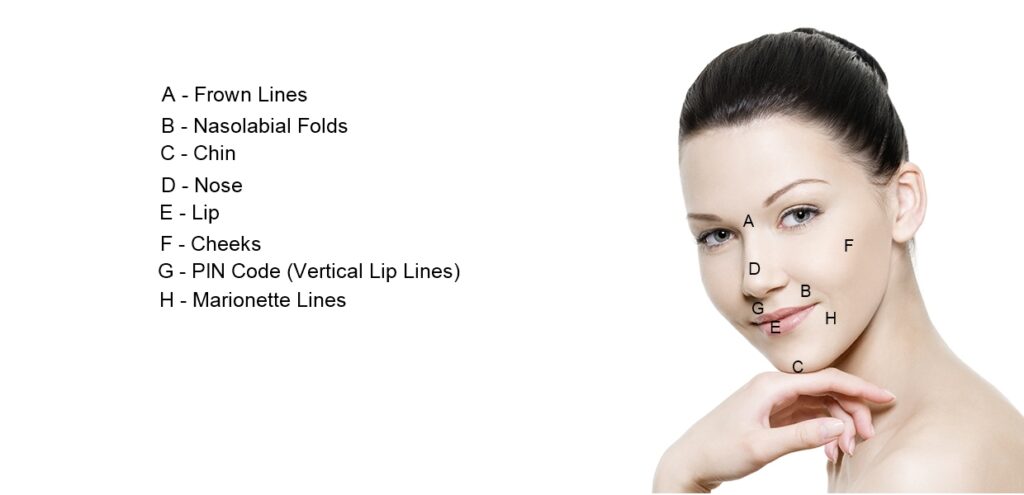Understanding Injectable Hyaluronic Acid:
The Secret of Youthful Radiance
Injectable hyaluronic acid is a powerhouse in the realm of aesthetics, renowned for its ability to restore volume, smooth wrinkles, and enhance facial contours. This naturally occurring substance is a hydrating marvel, attracting and retaining moisture to create a plump and youthful complexion.
Aesthetic Functions
From lip augmentation to wrinkle reduction, injectable hyaluronic acid offers a versatile solution to address various cosmetic concerns. Its non-surgical nature and immediate results make it a popular choice for those seeking a refreshed and revitalized appearance without the downtime associated with invasive procedures.
What is injectable hyaluronic acid used for?
- Wrinkle Reduction: Injectable hyaluronic acid is effective in smoothing out wrinkles and fine lines on the face. It helps restore volume and plumpness to areas where the skin has lost elasticity and firmness.
- Lip Augmentation: Many individuals opt for hyaluronic acid gel to enhance the volume and shape of their lips. It can create a fuller and more defined lip contour, providing a natural-looking and youthful appearance.
- Cheek Augmentation: HA dermal filler is used to add volume to the cheeks, addressing concerns related to sunken or flat cheekbones. This can result in a more lifted and sculpted facial profile.
- Nasolabial Folds and Marionette Lines: The filler is often employed to soften the appearance of nasolabial folds (lines that run from the nose to the corners of the mouth) and marionette lines (lines that extend from the corners of the mouth to the jawline).
- Facial Contouring: Hyaluronic acid injectables is utilized for facial contouring to define and shape specific areas of the face, such as the jawline or chin.
- Hydration and Radiance: Hyaluronic acid has exceptional water-binding properties. When injected, it attracts and retains moisture, providing deep hydration to the skin. This can result in a radiant and refreshed complexion.
- Non-Surgical Nose Job: Some individuals opt for injectable hyaluronic acid to reshape and refine the nose non-surgically. It can address minor irregularities and enhance nasal contours.
How does injectable hyaluronic acid work?
Injectable hyaluronic acid works by replenishing the body’s natural stores of this hydrating substance. When injected, it attracts and binds water molecules, adding volume to targeted areas and smoothing out wrinkles and fine lines.
How deep is hyaluronic acid injected?
The depth at which hyaluronic acid is injected depends on the specific treatment area and the aesthetic concern being addressed. Injectable hyaluronic acid fillers are typically administered into the deeper layers of the skin, specifically in the dermis or subcutaneous tissue, to achieve the desired effects. The depth can vary based on the purpose of the injection.
- Wrinkle Removal: When addressing wrinkles and fine lines, hyaluronic acid filler is often injected into the mid to deep dermal layers where it can add volume and fill in creases.
- Lip Augmentation: For lip enhancement, dermal filler is injected into the mucosa or the vermillion border of the lips. The injections are usually placed in the middle to deep layers of the lip tissue to create volume and definition.
- Cheek Augmentation: Injectable hyaluronic acid is typically injected into the deeper layers of the skin and soft tissues of the cheeks to add volume and lift.
- Nasolabial Folds and Marionette Lines: Injections for nasolabial folds and marionette lines are often placed in the mid to deep dermal layers, targeting the areas where lines and folds have formed.
- Facial Contouring: Facial contouring with hyaluronic acid gel involves injections into specific areas of the face, such as the jawline or chin. The depth of injection will depend on the targeted contours.
What is the success rate of hyaluronic acid injections?
The success rate of injectable hyaluronic acid varies depending on the specific purpose of the treatment, the area being addressed, and individual factors such as the patient’s skin type, overall health, and response to the filler. In general, hyaluronic acid injections are considered safe and effective when administered by trained and experienced medical professionals.
- Wrinkle Reduction and Facial Enhancement: When used for wrinkle reduction, facial contouring, or restoring volume to specific areas, injectable dermal filler can provide noticeable and satisfying results for many individuals. The success rate is generally high, and patients often appreciate the immediate and natural-looking outcomes.
- Lip Augmentation: Hyaluronic acid is commonly used for lip augmentation, and success rates are generally favorable. Patients can achieve fuller and more defined lips with a high level of satisfaction.
- Duration of Results: The duration of results varies among individuals and depends on factors such as the type of hyaluronic acid filler used, the treatment area, and the metabolism of the patient. Results typically last several months, and some products may provide longer-lasting effects.
- Safety Considerations: Hyaluronic acid is a naturally occurring substance in the body and is generally well-tolerated. Adverse reactions are rare but can include temporary redness, swelling, or bruising at the injection site. Serious complications are extremely uncommon when the injections are performed by qualified professionals.
- Patient Satisfaction: Patient satisfaction with hyaluronic acid injections is often high, particularly when the treatment goals align with the patient’s expectations. A thorough consultation with a skilled practitioner is essential to ensure that the treatment plan is tailored to the individual’s unique anatomy and desired outcomes.
How long to rest after hyaluronic acid injection?
After receiving hyaluronic acid injections, it’s generally advisable to take some precautions and allow for a brief period of rest to minimize the risk of complications and optimize the results.
- Immediate Aftercare: Directly after the injection, it’s common for the treated area to have some swelling, redness, and possibly bruising. The practitioner may apply ice or recommend over-the-counter pain relievers to help manage any discomfort.
- Avoid Strenuous Activities: It’s generally advisable to avoid strenuous physical activities, including vigorous exercise, for the first 24 to 48 hours after the injection. This helps minimize swelling and the potential for increased blood flow to the treated area.
- Avoid Sun Exposure and Heat: It’s recommended to avoid prolonged sun exposure and heat, including saunas and hot baths, for the first few days after the injection. This can help reduce the risk of swelling and bruising.
- Limit Alcohol Consumption: It’s advisable to limit alcohol consumption for the first 24 hours after the injection, as alcohol can contribute to increased bruising.
- Resuming Regular Activities: Most individuals can return to their regular activities shortly after hyaluronic acid injections. However, it’s important to listen to your body and avoid activities that may put stress on the treated area.

